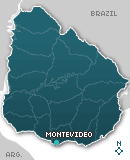Tours and Activities:
Brothers of Mate
Pablo Etchevers Pablo EtcheversUruguay has a tradition practiced by all its citizens: drinking mate. This article is addressed to all those who wish to learn about the history of yerbas, bombillas and plenty of caldera.

It is not exactly known when the history began, its reasons and truths, but the thing is that the Río de la Plata has divided into its banks two different forms of traditionalist consumption of what both countries are proud: the famous mate.
Uruguay, Argentina and mate are part of an inseparable trio whose codes, customs and even daily jargons allow talking about a phenomenon taking place only in this corner of the world that has come to be called “rioplatense”. With its fans and followers, mate has become an object of worship and tradition object for both countries.

Uruguayan or Charrúa Mate
Yerba without twigs is the result of a Portuguese tradition, according to which twigs and stems of all vegetables and leaf crops are removed due to the acidity they generate. Others assert that it is the leaf which has the highest nutritional value and that the twig does not contribute with anything. And there are those who assure that mate lasts longer that way. The truth is that the Uruguayan drink mate without twigs.
The opening of the container –also referred to as mate- is big enough so that a great amount of yerba may be used.
The Uruguayan mates are generally large and their capacity is remarkably bigger than that of Argentinian mates. They have been given the name of “porongos” and they are mostly made with gourds.
The container to heat the water is called “caldera”.
The consumption of mate is customized; this means that it is usual to see the Uruguayan in groups mateando (drinking mate), but instead of sharing the same gourd, each of them has their own equipment. Many people assert that this is a matter of hygiene; others assure this is done so that no one has to wait around for their turn.
The water has to be boiled before it is poured into the flask.

Argentinian Mate
In this case, the yerba contains twigs as the followers of this beverage assure that in addition to providing thickness to the drink, it contributes with nutritional and mineral values transmitted by the soil through the roots and the leaf stems.
The mouth of the mate is small, therefore the heat of the beverage is maintained. Of course less yerba is used.
Mates are much smaller than Uruguayan mates, both in size and volume. This is mainly because, as it is a shared element, it is necessary that "the round" be quick and that each of the drinkers is as fast as possible at the same time they enjoy it.
The container to heat the water is a kettle, which is called “pava” in the Argentinian dialect.
The consumption of mate takes place in groups and it is led by a person called “cebador” (the one pouring the water into the mate). The ritual of the round and of that who pours the mate is typically Argentinian. This is about sharing the moment or a chat among friends. The mate goes around one by one. “Matear” is a verb that refers to gathering and drinking mate until they run out of water, which means more water should be heated. When somebody feels like drinking no more, they should simply say gracias (thank you) to the cebador.

Coincidences between Brothers
Similarities emerge at first sight in the straws, the flasks, even the temperature of the water, which should nearly boil in order to let the yerba last longer.
For instance, the use of silver and nickel silver –called alpaca- in the making of the mates, precious metals abundant in the times of the conquest of the Río de la Plata region. Or else, in both cases, it is said that the yerba should be fixed when it has no more taste. It is said that the mate is lavado (washed out).
Differences go across the Río de la Plata once and again and they manage to mingle in such a way that we often forget which side of the river they come from. However, some qualities remain stable, which permits to create new products such as the “matera”, used to carry mate, flask, sugar and yerba mate, whose origin, just like that of tango and dulce de leche, is a constant reason for dispute (though friendly) between both countries, a part of the folklore of the Río de la Plata.
Beyond all differences and similarities, the important thing is that tradition is still in force and that it has managed to heroically rescue its great protagonist: this time, neither Argentinian nor Uruguayan, simply “rioplatense”.

© 2007-2025 Total or partial reproduction forbidden. Derechos de Autor 675244 Ley 11723


 See also:
See also: 



